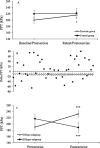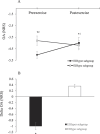Opposite effects of isometric exercise on pain sensitivity of healthy individuals: the role of pain modulation
- PMID: 39399304
- PMCID: PMC11469836
- DOI: 10.1097/PR9.0000000000001195
Opposite effects of isometric exercise on pain sensitivity of healthy individuals: the role of pain modulation
Abstract
Introduction: Exercise-induced hypoalgesia (EIHypo) among healthy individuals is well documented; however, the opposite effect of exercise, ie, exercise-induced hyperalgesia (EIHyper), has mainly been described in patients with chronic pain or after intense/painful exercise.
Objectives: We investigated the extent to which EIHypo and/or EIHyper occur among healthy participants and whether these responses are associated with individuals' pain modulation capacity.
Methods: Fifty-seven participants (mean age 29.20 ± 5.21 years) underwent testing of pressure pain threshold as an index of EIHypo/EIHyper: pain adaptation, offset analgesia (OA), and conditioned pain modulation as indices of pain modulation, prior to and immediately postsubmaximal isometric exercise (n = 40) or rest (n = 17, control group). Body awareness and exercise-evoked stress were also evaluated. Test-retest repeatability of the pain modulation indices was performed as well.
Results: Twenty-four participants (60%) exhibited EIHypo, whereas 16 (40%) exhibited EIHyper. Pressure pain threshold did not change in the control group. Baseline (preexercise) OA efficacy predicted EIHypo/EIHyper. Furthermore, OA significantly decreased postexercise in the EIHyper subgroup and slightly increased in the EIHypo subgroup. Exercise-induced hypoalgesia was associated with magnitude of daily exercise while EIHyper was associated with increased exercise-evoked stress and body awareness.
Conclusion: Submaximal isometric exercise can induce opposite effects on pain sensitivity among healthy participants-EIHypo or EIHyper. Descending pain inhibition pathways, and top-down influences over these pathways, seem to be involved in EIHypo/EIHyper effects. As such isometric exercise is often preferred in early stages of rehabilitation, preliminary screening individuals' vulnerability to this exercise is important; OA test may be used for this purpose.
Keywords: Descending modulation; Exercise; Interoceptive; Pain perception; Stress.
Copyright © 2024 The Author(s). Published by Wolters Kluwer Health, Inc. on behalf of The International Association for the Study of Pain.
Conflict of interest statement
The authors have no conflicts of interest to declare. Data available within the article. Supporting data available on request from the authors.
Figures



References
-
- Arnett DK, Blumenthal RS, Albert MA, Buroker AB, Goldberger ZD, Hahn EJ, Himmelfarb CD, Khera A, Lloyd-Jones D, McEvoy JW, Michos ED, Miedema MD, Muñoz D, Smith SC, Jr, Virani SS, Williams KA, Sr, Yeboah J, Ziaeian B. 2019 ACC/AHA guideline on the primary prevention of cardiovascular disease: executive summary: a report of the American College of Cardiology/American Heart Association Task Force on Clinical Practice Guidelines. J Am Coll Cardiol 2019;74:1376–414. - PMC - PubMed
-
- Arroyo-Morales M, Rodríguez LD, Rubio-Ruiz B, Olea N. Influence of gender in the psychoneuroimmunological response to therapeutic interval exercise. Biol Res Nurs 2012;14:357–63. - PubMed
-
- Bingel U, Schoell E, Herken W, Büchel C, May A. Habituation to painful stimulation involves the antinociceptive system. PAIN 2007;131:21–30. - PubMed
-
- Black CD, Huber JK, Ellingson LD, Ade CJ, Taylor EL, Griffeth EM, Janzen NR, Sutterfield SL. Exercise-induced hypoalgesia is not influenced by physical activity type and amount. Med Sci Sports Exerc 2017;49:975–82. - PubMed
LinkOut - more resources
Full Text Sources
Research Materials
